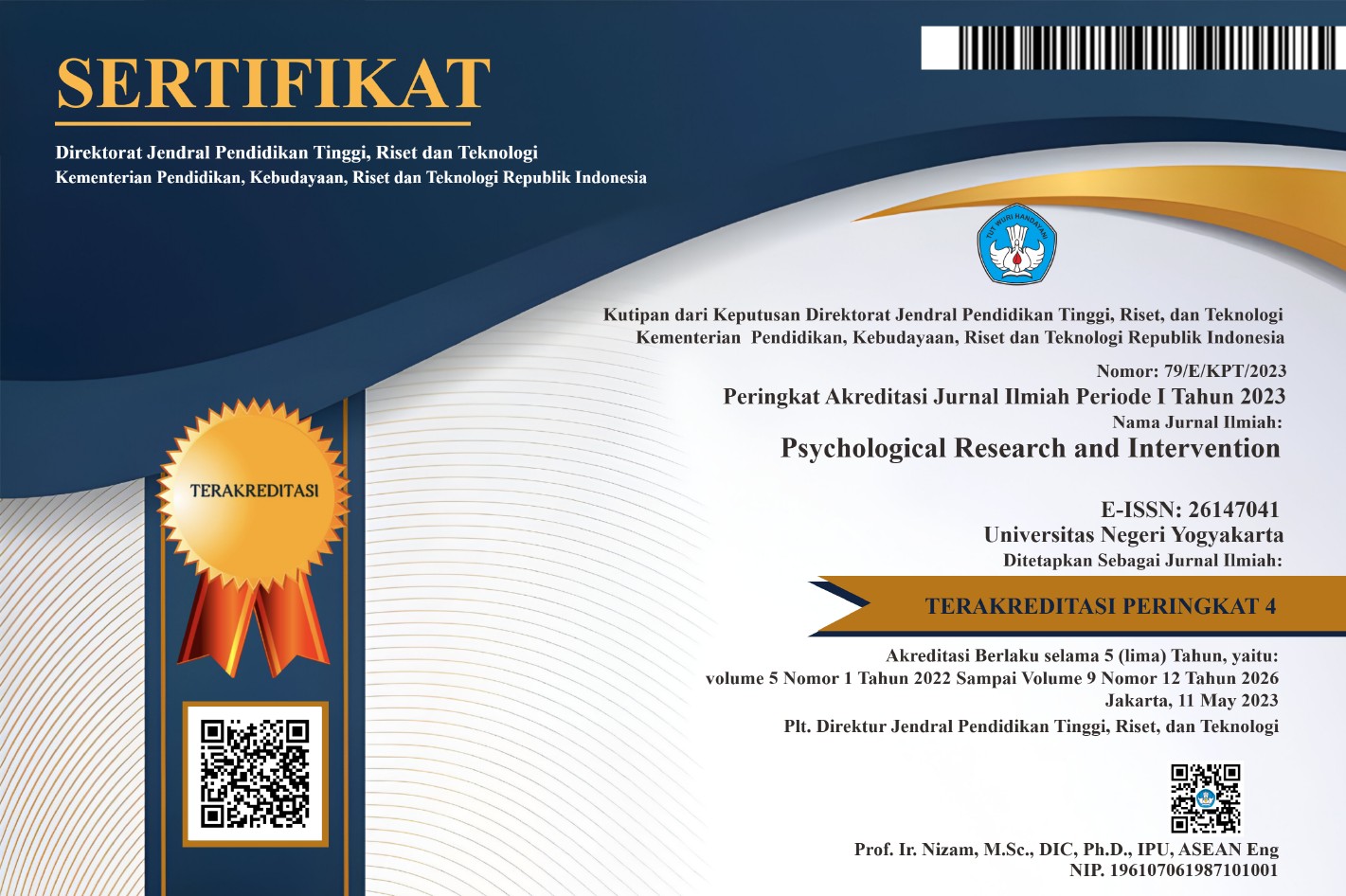Understanding the dynamics of friendship formation among high school adolescent: Indigenous psychology approach
DOI:
https://doi.org/10.21831/pri.v2i1.28048Keywords:
Friendship, Friendship Formation, AdolescentAbstract
How friendship between adolescent peers was formed is yet to be understood clearly. Whereas number of studies has clearly linked quality of friendship to various adaptive ability, school performance, and academic achievements. This study attempted to understand the dynamics of friendship formation in sample Javanese adolescents using indigenous psychology as its' paradigm. Data was obtained from 120 respondents, (82 Girls, and 38 Boys) using open-ended questionnaire, which asks about how friendship between the respondent and their best friend(s) was formed. Data was analyzed using thematic analysis to identify themes and subthemes that indicates how friendship was formed. The result showed that there are two major theme that emerges in the beginning of friendship formation followed by other qualities related to it. This study reveals one more important aspect to be considered in understanding friendship formation between adolescents and their close friendsReferences
Adams, R. G., Blieszner, R., & de Vries, B. (2000). Definitions of friendship in the third age: age, gender, and study location effects. Journal of Aging Studies, 14(1), 117-133. doi:10.1016/S0890-4065(00)80019-5
Austin, A. M., & Draper, D. C. (1984). The Relationship Among Peer Acceptance, Social Impact, and Academic Achievement in Middle Childhood. The American Educational Research Journal, 21(3), 597-604. doi:10.3102%2F00028312021003597
Braun, V., & Clarke, V. (2006). Using thematic analysis in psychology. Qualitative Research in Psychology, 3(2), 77-101. doi:10.1191/1478088706qp063oa
Brown, B. B., & Klute, C. (2003). Friendships, cliques, and crowds. In G. R. Adams, & M. D. Berzonsky (Eds.), Blackwell Handbook of Adolescence (pp. 330-348). Malden: Blackwell Publishing.
Caroline, H. A. (1993). Explorations of Close Friendships: A Concept Analysis. Archives of Psychiatric Nursing, 7(4), 236-243. doi:10.1016/0883-9417(93)90032-R
Collins, W. A., & Steinberg, L. (2006). Adolescent Development in Interpersonal Context. In W. Damon, & R. Lerner (Eds.), Handbook of Child Psychology (6th ed.). New York: Wiley.
Costa, A. C. (2004). Trust. In C. Spielberger (Ed.), Encyclopedia of Applied Psychology (Vol. 3, pp. 611-620). Oxford: Elsevier Inc.
Creswell, J. W. (2009). Research Design: Qualitative, Quantitative, and Mixed Methods Approaches. Thousand Oaks, CA: Sage.
Fehr, B. (2000). The life cycle of friendship. In C. Hendrick, & S. S. Hendrick (Eds.), Close Relationships: a Sourcebook (pp. 71-82). London: Sage Publications, Inc.
Fiske, A. P. (2004). Relational Models Theory 2.0. In H. Nick (Ed.), Relational Models Theory: A Contemporary Overview (pp. 3-25). Mahwah, NJ: Lawrence Erlbaum.
Gallardo, L., Barrasa, A., & Guevara-Viejo, F. (2016). Positive peer relationships and academic achievement across early and midadolescence. Social Behavior and Personality: An international journal, 44(10), 1637-1648. doi:10.2224/sbp.2016.44.10.1637
Hall, C. S., & Lindzey, G. (1978). Theories of Personality (3rd ed.). New York: John Wiley & Sons.
Hartup, W., & Stevens, N. (1997). Friendships and Adaptation in the Life Course. Psychological Bulletin, 121(3), 355-370. doi:10.1037/0033-2909.121.3.355
Jersild, A. T. (1965). The Psychology of Adolescence (2nd ed.). New York: The Macmillan Company.
Kerckhoff, A. C., & Davis, K. E. (1962). Value Consensus and Need Complementarity in Mate Selection. American Sociological Review, 27(3), 295-303. doi:10.2307/2089791
Kim, U., & Berry, J. W. (1993). Indigenous Psychologies: Experience and Research in Cultural Context. Newbury Park, CA: Sage.
Kim, U., Yang, K. S., & Hwang, K. K. (2006). Contributions to Indigenous and Cultural Psychology: Understanding People in Context. In U. Kim, K. S. Yang, & K. K. Hwang (Eds.), Indigenous and Cultural Psychology: Understanding People in Context (pp. 3-26). New York: Springer.
Košir, K., & Tement, S. (2014). Teacher-student relationship and academic achievement: a cross-lagged longitudinal study on three different age groups. European Journal of Psychology of Education, 29(3), 409-428. doi:10.1007/s10212-013-0205-2
Lee, J. S. (2012). The effects of the teacher–student relationship and academic press on student engagement and academic performance. International Journal of Educational Research, 53, 330-340. doi:10.1016/j.ijer.2012.04.006
Reis, H. T., Collins, W. A., & Berscheid, E. (2000). The relationship context of human behavior and development. Psychological Bulletin, 126(6), 844-872. doi:10.1037/0033-2909.126.6.844
Rice, F. P., & Dolgin, K. G. (2008). The Adolescent: Development, Relationships, and Culture (10th ed.). Boston: Allyn and Bacon.
Russel, A., Mize, J., & K, B. (2002). Parent-Child Relationships. In P. K. Smith, & C. H. Hart (Eds.), Blackwell Handbook of Childhood Social Development (pp. 205-222). Oxford: Blackwell Publishers Ltd.
Shaugnessy, J. J., Zechmeister, E. B., & Zechmeister, J. S. (2012). Research Methods in Psychology (9th ed.). New York: McGraw-Hill.
Sullivan, H. S. (1953). The Interpersonal Theory of Psychiatry. New York: W. W. Norton.
Wentzel, K. R., & Caldwell, K. (1997). Friendships, peer acceptance, and group membership: relations to academic achievement in middle school. Child Development, 68(6), 1198-1209. doi:10.1111/j.1467-8624.1997.tb01994.x
Wicaksono, B., Adiwibowo, I. R., & Faturochman. (2013). Adolescent Criteria for Trusting Their Close Friend. In R. Ismail, U. Kim, & S. M. Iqbal (Eds.), International Conference of Asian Association of Indigenous and Cultural Psychology 2012 Proceeding (pp. 106-125). Perlis: Percetakan Madani.
Woodhouse, S. S., Dykas, M. J., & Cassidy, J. (2012). Loneliness and Peer Relations in Adolescence. Social Development, 21(2), 273-293. doi:10.1111/j.1467-9507.2011.00611.x












